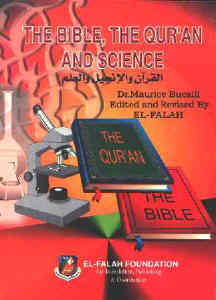Bible,Quran and Science

|
|
The GospelsIntroduction Many readers of the Gospels are embarrassed and even abashed when they stop to think about the meaning of certain descriptions. The same is true when they make comparisons between different versions of the same event found in several Gospels. This observation is made by Father Roguet in his book Initiation to the Gospels (Initiation à l'Evangile) [ Pub. Editions du Seuil, Paris, 1973]. With the wide experience he has gained in his many years of answering perturbed readers' letters in a Catholic weekly, he has been able to assess just how greatly they have been worried by what they have read. His questioners come from widely varying social and cultural backgrounds. He notes that their requests for explanations concern texts that are "considered abstruse, incomprehensible, if not contradictory, absurd or scandalous'. There can be no doubt that a complete reading of the Gospels is likely to disturb Christians profoundly. This observation is very recent: Father Roguet's book was published in 1973. Not so very long ago, the majority of Christians knew only selected sections of the Gospels that were read during services or commented upon during sermons. With the exception of the Protestants, it was not customary for Christians to read the Gospels in their entirety. Books of religious instruction only contained extracts; the in extenso text hardly circulated at all. At a Roman Catholic school Ihad copies of the works of Virgil and Plato, but I did not have the New Testament. The Greek text of this would nevertheless have been very instructive: it was only much later on that I realized why they had not set us translations of the holy writings of Christianity. The latter could have led us to ask our teachers questions they would have found it difficult to answer. These discoveries, made if one has a critical outlook during a reading in extens of the Gospels, have led the Church to come to the aid of readers by helping them overcome their perplexity. "Many Christians need to learn how to read the Gospels", notes Father Roguet. Whether or not one agrees with the explanations he gives, it is greatly to the author's credit that he actually tackles these delicate problems. Unfortunately, it is not always like this in many writings on the Christian Revelation. In editions of the Bible produced for widespread publication, introductory notes more often than not set out a collection of ideas that would tend to persuade the reader that the Gospels hardly raise any problems concerning the personalities of the authors of the various books, the authenticity of the texts and the truth of the descriptions. In spite of the fact that there are so many unknowns concerning authors of whose identity we are not at all sure, we find a wealth of precise information in this kind of introductory note. Often they present as a certainty what is pure hypothesis, or they state that such-and-such an evangelist was an eye-witness of the events, while specialist works claim the opposite. The time that elapsed between the end of Jesus' ministry and the appearance of the texts is drastically reduced. They would have one believe that these were written by one man taken from an oral tradition, when in fact specialists have pointed out adaptations to the texts. Of course, certain difficulties of interpretation are mentioned here and there, but they ride rough shod over glaring contradictions that must strike anyone who thinks about them. In the little glossaries one finds among the appendices complementing a reassuring preface, one observes how improbabilities, contradictions or blatant errors have been hidden or stifled under clever arguments of an apologetic nature. This disturbing state of affairs shows up the misleading nature of such commentaries. The ideas to be developed in the coming pages will without doubt leave any readers still unaware of these problems quite amazed. Before going into detail however, I will provide an immediate illustration of my ideas with an example that seems to me quite conclusive. Neither Matthew nor John speaks of Jesus's Ascension. Luke in his Gospel places it on the day of the Resurrection and forty days later in the Acts of the Apostles of which he is said to be the author. Mark mentions it (without giving a date) in a conclusion considered unauthentic today. The Ascension therefore has no solid scriptural basis. Commentators nevertheless approach this important question with incredible lightness. A. Tricot, in his Little Dictionary of the New Testament (Petit Dictionnaire du Nouveau Testament) in the Crampon Bible, (1960 edition) [ Pub. Desclée and Co., Paris.], a work produced for mass publication, does not devote an entry to the Ascension. The Synopsis of the Four Gospels (Synopse des Quatre Evangiles) by Fathers Benoît and Boismard, teachers at the Biblical School of Jerusalem, (1972 edition) [ Pub. Editions du Cerf, Paris], informs us in volume II, pages 451 and 452, that the contradiction between Luke's Gospel and the Acts of the Apostles may be explained by a 'literary artifice': this is, to say the least, difficult to follow ! . In all probability, Father Roguet in his Initiation to the Gospel, 1973, (pg. 187) has not been convinced by the above argument. The explanation he gives us is curious, to say the least: '"Here, as in many similar cases, the problem only appears insuperable if one takes Biblical statements literally, and forgets their religious significance. It is not a matter of breaking down the factual reality into a symbolism which is inconsistent, but rather of looking for the theological intentions of those revealing these mysteries to us by providing us with facts we can apprehend with our senses and signs appropriate to our incarnate spirit." How is it possible to be satisfied by an exegesis of this kind. Only a person who accepted everything unconditionally would find such apologetic set-phrases acceptable. Another interesting aspect of Father Roguet's commentary is his admission that there are 'many similar cases'; similar, that is, to the Ascension in the Gospels. The problem therefore has to be approached as a whole, objectively and in depth. It would seem reasonable to look for an explanation by studying the conditions attendant upon the writing of the Gospels, or the religious atmosphere prevailing at the time. When adaptations of the original writings taken from oral traditions are pointed out, and we see the way texts handed down to us have been corrupted, the presence of obscure, incomprehensible, contradictory, improbable, and even absurd passages comes as much less of a surprise. The same may be said of texts which are incompatible with today's proven reality, thanks to scientific progress. Observations such as these denote the element of human participation in the writing and modification of the texts. Admittedly, in the last few decades, objective research on the Scriptures has gained attention. In a recent book, Faith in the Resurrection, Resurrection of Faith [ Pub. Beauchesne, Coll. 'Le Point théologique'. Paris. 1974] (Foi en la Resurrection, Resurrection de la foi), Father Kannengiesser, a professor at the Catholic Institute of Paris, outlines this profound change in the following terms: "The faithful are hardly aware that a revolution has taken place in methods of Biblical exegesis since the time of Pious XII" [ Pious XII was Pope from 1939 to 1959]. The 'Revolution' that the author mentions is therefore very recent. It is beginning to be extended to the teaching of the faithful, in the case of certain specialists at least, who are animated by this spirit of revival. "The overthrow of the most assured prospects of the pastoral tradition," the author writes, "has more or less begun with this revolution in methods of exegesis." Father Kannengiesser warns that 'one should not take literally' facts reported about Jesus by the Gospels, because they are 'writings suited to an occasion' or 'to combat', whose authors 'are writing down the traditions of their own community about Jesus'. Concerning the Resurrection of Jesus, which is the subject of his book, he stresses that none of the authors of the Gospels can claim to have been an eye-witness. He intimates that, as far as the rest of Jesus's public life is concerned, the same must be true because, according to the Gospels, none of the Apostles-apart from Judas Iscariot-left Jesus from the moment he first followed Him until His last earthly manifestations. We have come a long way from the traditional position, which was once again solemnly confirmed by the Second Vatican Council only ten years ago. This once again is resumed by modern works of popularization destined to be read by the faithful. Little by little the truth is coming to light however. It is not easy to grasp, because the weight of such a bitterly defended tradition is very heavy indeed. To free oneself from it, one has to strike at the roots of the problem, i.e. examine first the circumstances that marked the birth of Christianity. |
